QuestionQUESTION: I have had a red eared slider for about 10 months now. The length f its shell is approximately 2.5-3 inches. Recently I bought another baby red eared slider. The length of its shell is approximately 1 inch. I added the baby turtle a little over a week ago to a 30 gallon tank. Both turtles live together. Since I have added the baby turtle, it has not eaten a single thing (that I can tell). It seems healthy. It moves around, its eyes are open and clear, and its body isn't injured at all. Yet for some reason I can't get it to eat. I tried putting it in a plastic container with a bit of water and added some food yet that didn't work. I put it in a small 10 gallon tank with a few inches of water and a little rock for it to sit on WITH basking light for a few days and it still didn't eat. I am completely stumped. I don't know why it isn't eating. The other turtle eats perfectly fine. Both turtles get along with each other. My bigger turtle bit the shell of the other turtle once right after I put it in but that was it. Now they get along fine. I feed the turtles 'Wardley Reptile Premium Stock'. Please help. Lately I've also been noticing that the baby has been sleeping under water during the day as well as at night. I don't know if that is normal or not.
I should also add the both turtles are scared of me. Every time I walk in the room they will both jump off their floating platform and hide for a few minutes. Although for some reason when I feed the big one, he has no problem eating from my hand (but the little one swims and hides). I have tried staying completely out of sight while I feed them (by throwing the food in the tank). They do not swim away and hide but even when the food floats in front of the little one, it does not seem interested in it. I appreciate any and all advice.
Thanks!
ANSWER: Hi, Mitch,
Can you describe your setup? Exact temperatures, lighting, size of enclosure, etc?
Turtle pellets may make up to 30% of a turtle's diet, but should not be the only thing they eat. Baby turtles are very delicate. (I'm not sure where you are, but in the US, turtles under 4 inches in shell length are banned from being sold as pets).
The little turtle may find live food to be more appealing, so try offering bloodworms, tubifex worms, small feeder guppies, chopped earthworm, etc.
Older RES tend to eat more greens. Dandelion greens, mustard greens, turnip tops, and collards are good choices.
I really don't recommend housing two turtles of different sizes together. The larger turtle will increasingly dominate the smaller one, and may keep it from getting adequate nutrition, as well as contributing to stress. If the smaller turtle is ill, that illness may now have been passed on to the larger one. New reptiles should be quarantined for 3 to 6 months before being introduced to existing animals. (With snakes, it should be as much as 12 months).
Aquatic turtles are quite a commitment of space and time. Red eared sliders grow very large.
---------- FOLLOW-UP ----------
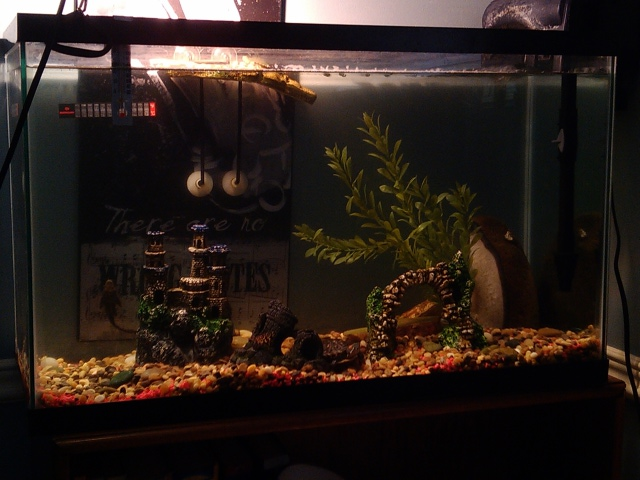 Full tank
Full tank 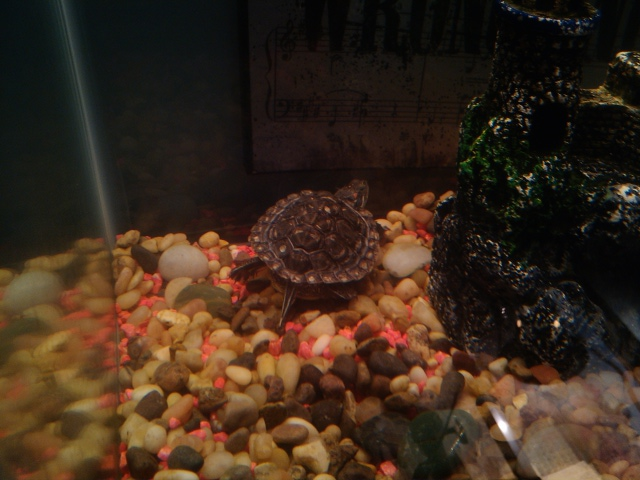 Big turtle
Big turtle
QUESTION: I keep the tank at approximately 72 degrees (fluctuates throughout the day). I have 1 100W 120V heat lamp. I have a 50gph Marineland filter that hangs off the side of the tank. The tank itself is 30g, approx. 1.5 feet high, 2.5 feet in length, and 1.2 feet in width.
Asking this may be too specific and you may not have enough information to answer it, but what would you recommend as a healthy weekly diet for the turtles? I know babies are fragile and I have to be careful. From what I know, baby turtles are supposed to eat every day where are bigger turtles are supposed to eat once every two days.
Should I put the baby turtle in a different tank until it grows bigger?
I sent a picture of my tank as well as a picture of both turtles.
AnswerYou did not mention a UVB light, or the temperatures on their basking platform. Basking temperatures should be between 90F and 95F, and it is important to stay within this range. You can raise or lower the heat lamp to achieve the correct temperature. A thermometer with a remote probe (such as and indoor/outdoor model) is best for recording accurate temperatures.
Turtles kept indoors must have a UVB producing reptile light. If fluorescent, it should be within 6 inches (maximum) from the turtle. They must be replaced every 6 months. The new Mercury-Vapor reptile lights can throw UVB for over a foot, and double as a heat lamp, so are probably a better choice for turtles. They last for 3 years.
You may be disappointed to hear that your current tank, while the correct size for the turtles at present, will not be the correct size once they begin to grow...in a few months, at most, they will have outgrown it. The general rule is 10 gallons per inch of shell length, minimum. Moving the smaller turtle to a separate enclosure will help with this as well, but the turtle will need all of the equipment that the first one has.
I recommend you consider a turtle tub or plastic bin enclosure rather than a glass tank. Tanks are heavy and fragile, and as a result, people clean them less often than they need to. From what I can see of your tank, you have it set up in a fashion that would be more appropriate for fish. Turtles can't be kept the way fish are--the tank will not cycle biologically the way it does with fish, as turtles are simply too messy, even with the best, biggest filter. You will need to regularly drain it and scrub it out, and disinfect it. I see that you have gravel on the bottom as well--this simply traps waste, and if the turtles swallow it, it will block their intestinal tract. It should be removed. A bare tank bottom is best for turtles.
It seems as though you may have fallen prey to pet store recommendations...pet stores notoriously give out bad information on how to care for reptiles, and seriously underplay how much equipment, work, and space turtles require.
Here is an excellent website on turtle care:
http://www.austinsturtlepage.com/
You will be able to find advice on equipment, diet, and more, there. Red-eared sliders grow to be 6 to 12 inches in length. (Males are 5 to 8 inches, females 10 to 13 inches). For two turtles, assuming you have 2 females, or one male and one female, you will need something the size of a 200 gallon tank by the time they're 4 or 5 years old. If both of your turtles turn out to be males, they cannot be housed together. This is the reason why red-eared sliders wind up in rescues so often.



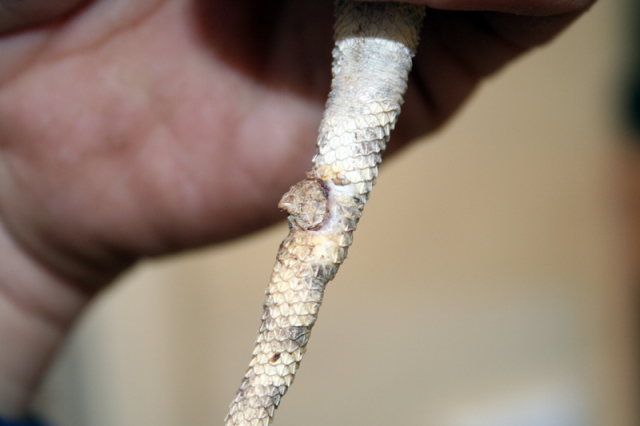 Egyptian Agama
Question
Egytian Agama tail 1
Hello Diane
I recently
Egyptian Agama
Question
Egytian Agama tail 1
Hello Diane
I recently
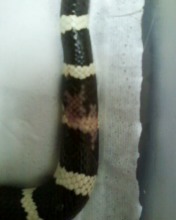 tea tree oil
QuestionQUESTION: I have a baby California king snake,
tea tree oil
QuestionQUESTION: I have a baby California king snake,
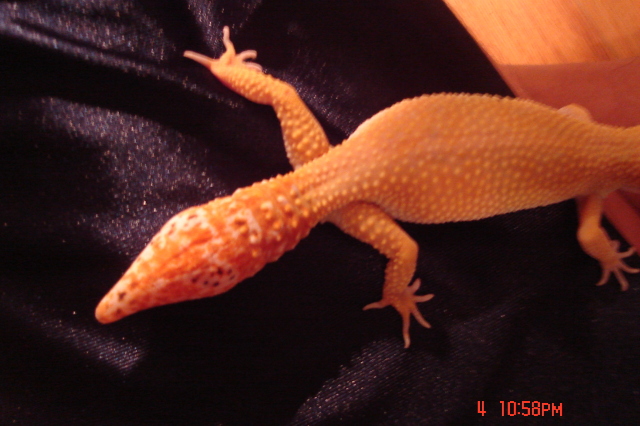 dystocia or not
Questiontail
QUESTION: Hi Diane. How are you tod
dystocia or not
Questiontail
QUESTION: Hi Diane. How are you tod
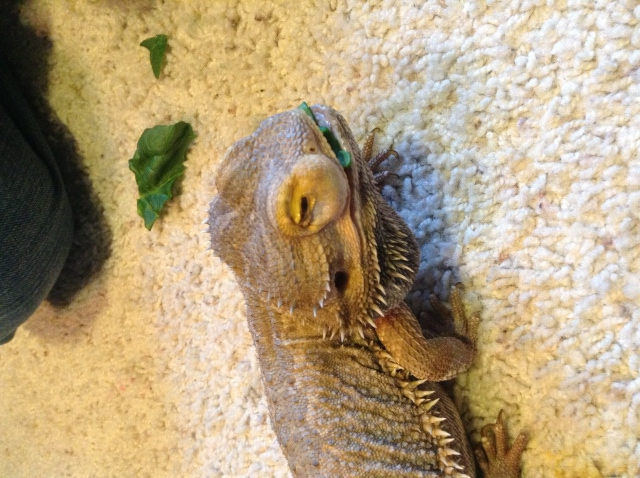 Rex hypovitaminosis A
Question
Rex Rex
This is the picture of hi
Rex hypovitaminosis A
Question
Rex Rex
This is the picture of hi
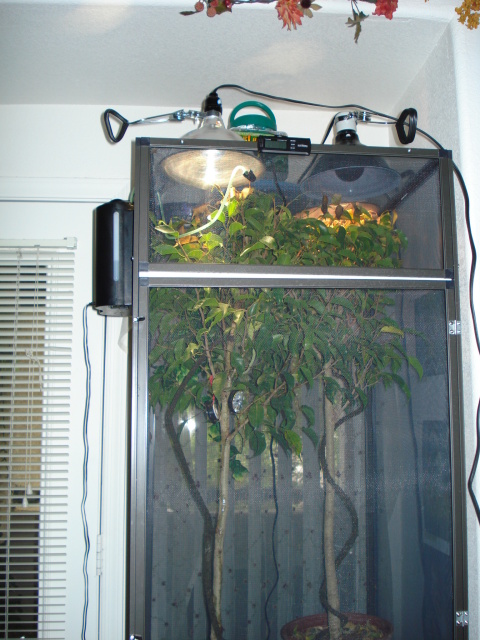 female jackson with right swollen knee
QuestionQUESTION: Hello I got this beautiful female jac
female jackson with right swollen knee
QuestionQUESTION: Hello I got this beautiful female jac